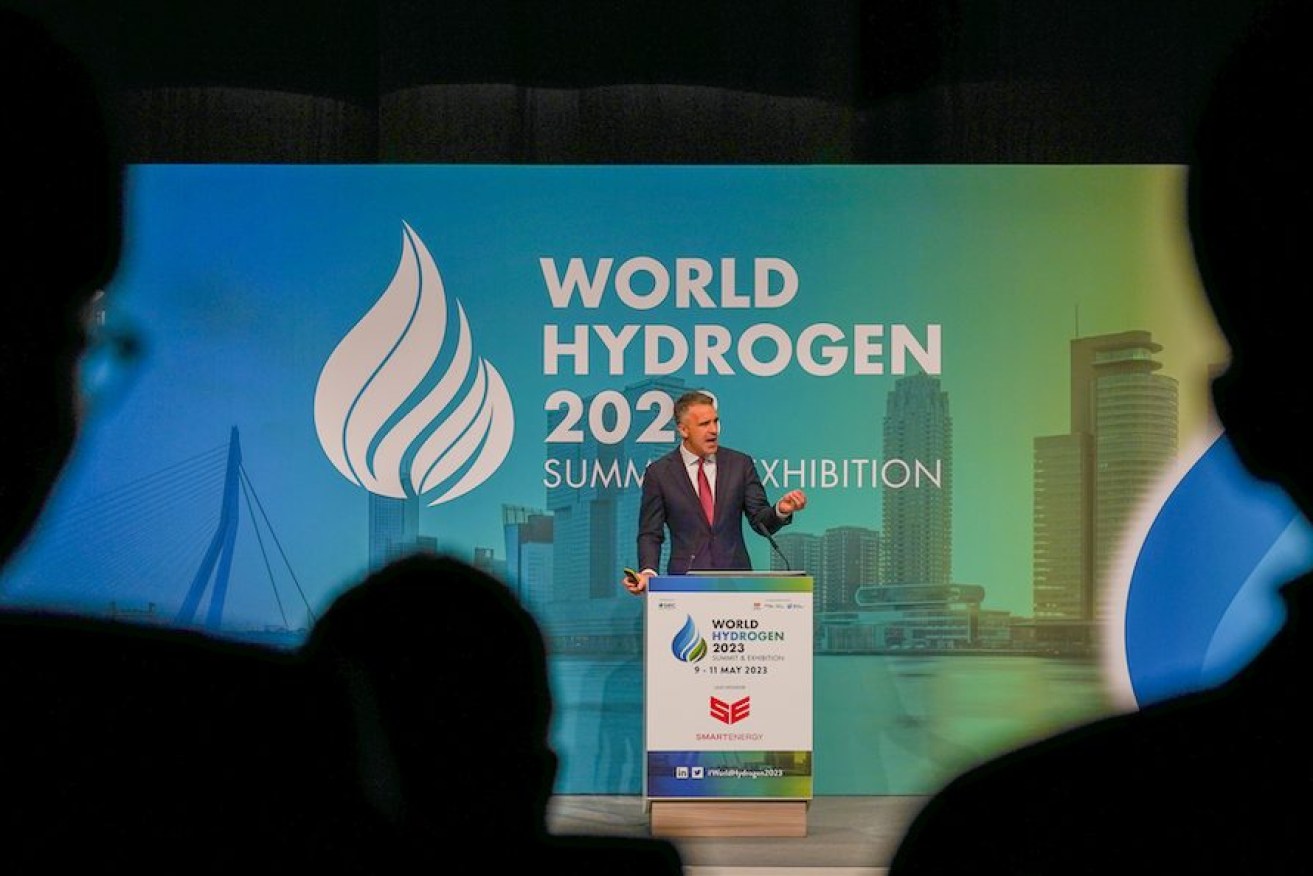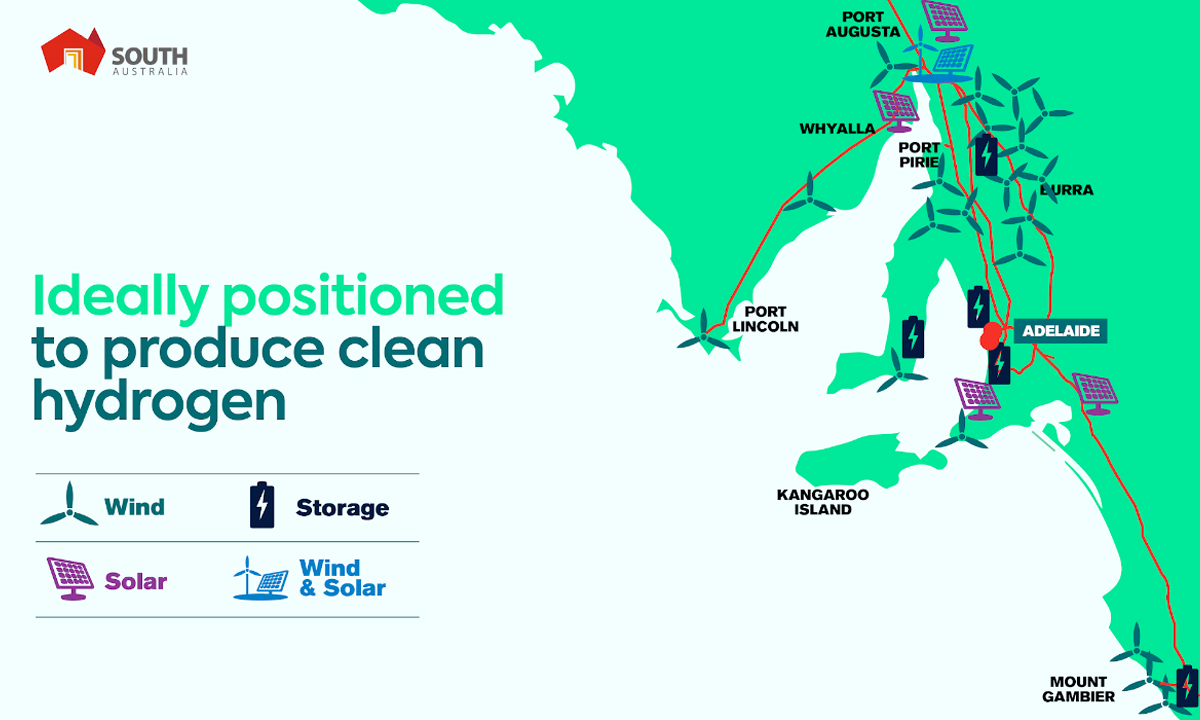Interstate rivals challenge Premier’s global hunt for hydrogen dollars
Queensland and Western Australia are fighting for their own share of hydrogen investors as the Premier works on his big sell to build a $593 million hydrogen plant in Whyalla, announcing new rules to attract potential punters in Europe. See the video.


It was during a keynote address at the World Hydrogen Summit in The Netherlands when Premier Peter Malinauskas flagged introducing a “world first” act to slash red tape for potential hydrogen investors.
Renewable energy projects in South Australia currently negotiate a plethora of checks and balances to get projects underway – the Electricity Act 1996, Petroleum and Geothermal Energy Act 2000, Landscapes SA Act 2019, Planning, Development and Infrastructure Act 2016, Gas Act 1997 and Harbors and Navigations Act 1993.
But Malinauskas wanted global investors to know the planned Hydrogen and Renewable Energy Act would make it far easier for companies wanting to invest in large-scale hydrogen and renewable energy projects in South Australia than other states or countries.
“This world-first Hydrogen and Renewable Energy Act will establish an orderly, fit-for-purpose system to ensure that developments are assisted by a ‘one window to government’ approach,” he said at the summit attracting more than 8,000 people.
The state’s new project is already generating global attention. A call went out in December last year for companies to register their interest in building the hydrogen power station, electrolyser and storage facility in Whyalla and by March there were 29 proposals lodged from around the world.
Bids came in from Australia, Europe, North and South America and the Asia Pacific with the State Government likely to pick a winner within months so contracts can be signed later this year and a build started by the end of 2025.
But South Australia is not the only hydrogen horse in the race for investors with Queensland and Western Australia advanced in their own plans to build a new energy industry.
Last Tuesday, the Queensland government staked its own claim announcing it too was tweaking legislation to ensure it was safeguarding “the state’s natural wonders and securing new jobs and export potential for Queensland’s booming renewable energy industry”.
“The Gas Supply and Other Legislation (Hydrogen Industry Development) Amendment Bill 2023 will ensure Queensland has the policy settings in place to lead energy export partners, including Japan and South Korea, on their journey to net-zero,” relevant ministers announced in a media release.
The release claimed it is Queensland that is “already leading the charge in the hydrogen sector” and that there are already “more than 50 hydrogen projects currently underway across the state, including Stanwell Energy’s mega $12.4 billion Central Queensland Hydrogen Hub at Gladstone Port.”
“The proposed changes to the Petroleum and Gas (Production and Safety) Act 2004 will position Queensland as a destination of choice for investors looking to be part of the green hydrogen revolution,” Queensland resources minister Scott Steward said.
In WA, the government is spending almost $90 million to drive its WA Renewable Hydrogen Strategy to focus on developing a hydrogen industry, including exports, remote applications, hydrogen blending in natural gas networks and transport.
It means Malinauskas is having to stay focused on selling his own state’s credentials, and he was keen to tell the hydrogen conference in The Netherland’s city of Rotterdam about SA growing its renewable energy production from one per cent just over 15 years ago to its current 70 per cent benchmark.
He also met with potential investors in Germany beforehand, later announcing that SA would open a new trade office in that country at a cost of $250,000 a year as it was the biggest player in green hydrogen in Europe.
The trip was building on another overseas hydrogen push in Japan and South Korea earlier this year where Resources Minister Tom Koutsantonis and Trade Minister Nick Champion joined the Premier at meetings with other potential hydrogen investors.
“I am travelling to Japan and Korea to send a clear message: South Australia is open for business and we are ambitious about hydrogen,” he said at the time.
“I have chosen Japan and Korea for my first overseas trade mission because they are two of the world’s biggest players when it comes to green hydrogen.”
There was other good news for hydrogen projects last week when Federal Treasurer Jim Chalmers announced a $2 billion Hydrogen Headstart program in the Federal Budget to invest in projects producing and exporting hydrogen energy, promisingly for SA, Chalmers specifically highlighted opportunities in green steel production in Whyalla.
On ABC Radio this morning, the Premier acknowledged the state “is in a race with WA and Queensland” to win its share of funds.
Behind the scenes, SA is working hard on its game plan. The Hydrogen and Upper Spencer Gulf Cabinet Taskforce regularly meets to keep the project moving forward and a dedicated Office for Hydrogen Power was established under Malinauskas’s watch, led by chief executive officer Sam Crafter.
This has led to extensive work being undertaken to identify the best sites for the hydrogen power plant, production and storage facilities at Whyalla – a site that can utilise nearby renewable energy sources and water to make hydrogen that could supply the Whyalla steel plant along with mines like Olympic Dam in the north of the state.

Premier Peter Malinauskas told an international hydrogen audience in The Netherlands last week that SA has the ideal set up for a plant. Photo: supplied
A spokesman for Minister Koutsantonis said the sites are located within a 15-kilometre radius to the northeast of the city of Whyalla, close to critical infrastructure, transport nodes, and existing and planned economic development.
Sites include a substantial parcel of land in the Whyalla Industrial Estate and 8.7 hectares located at the intersection of Port Bonython Road and the Lincoln Highway in the Cultana Industrial Estate – the preferred sites for the location of the hydrogen production facility and hydrogen power station respectively.
There is also potential for site connection through a dedicated hydrogen pipeline, providing both hydrogen storage and direct supply connection.
A third site adjacent to the Cultana Industrial Estate provides an opportunity for power generation and other infrastructure for the project, he said.
“With growing international demand for clean fuels from renewable sources, including hydrogen, South Australia is well-positioned to provide globally significant opportunities in the net zero transition,” Minister Koutsantonis said as he reinforced the government’s message to potential investors.
“Our Hydrogen and Renewable Energy Act sends a clear message to investors we are open for business when it comes to renewable and hydrogen projects.”




